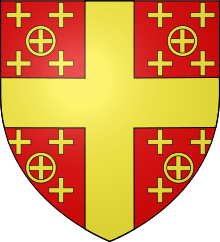Genoese occupation of Rhodes
| ||||||||||||||||||||||
The Genoese occupation of Rhodes refers to the period between 1248 and late 1249/early 1250 during which the city of Rhodes and parts of the island were under Genoese control. The Genoese took possession of the city and island, a dependency of the Empire of Nicaea, in a surprise attack in 1248, and held it, with aid from the Principality of Achaea, against Nicaean attacks until 1250.
Background
Rhodes and its nearby islands had been detached from the control of the central Byzantine government already since before the fall of Constantinople to the Fourth Crusade in 1204. Under the rule of the Caesar Leo Gabalas, the island became the center of a practically independent domain, although at times Gabalas seems to have acknowledged the suzerainty of the major Byzantine Greek successor state, the Empire of Nicaea.[1][2] Leo's brother and successor, John Gabalas, who succeeded him probably in the early 1240s, was clearly in a less powerful position, as he is only mentioned as "Master of Rhodes".[1]
Genoese occupation and Nicaean reconquest
In 1248, when John Gabalas was absent from the island in a Nicaean campaign against the Latin Empire, the Genoese exploited his absence and in a surprise night attack seized the city of Rhodes, the island's capital, and soon expanded their control over the remainder of the island. The Nicaean emperor, John III Vatatzes, reacted swiftly, sending a fleet to the island, led by the pinkernes and doux of the Thracesian Theme, John Kantakouzenos. Kantakouzenos, although he did not have many men, managed to recover the fortress towns of Lindos and Phileremos. As soon as reinforcements arrived, he moved against the island's capital, where he blockaded the Genoese.[3][4]
Kantakouzenos laid siege to the city, but Rhodes was well provisioned and the siege continued over the winter of 1248–1249 into spring. According to the account of George Akropolites the city was on the verge of falling, when, in early May 1249, William II of Villehardouin, the Prince of Achaea, arrived on the island on his way to join the Eighth Crusade in the Holy Land. This caused the Nicaeans to raise the siege and fall back to Phileremos. William quickly concluded an agreement with the Genoese, and left behind a hundred of his knights to aid them before departing for the Holy Land. The Genoese now reversed the situation and besieged the Greeks at Phileremos both by land and sea, while the Achaeans ravaged the countryside.[3][4]
When Emperor John Vatatzes was informed of these events, he went to Nymphaion, and ordered another expeditionary force to be prepared in Smyrna, comprising 300 horse under the protosebastos Theodore Kontostephanos, to whom Vatatzes gave written instructions for the campaign. The arrival of Kontostephanos and his men once again tipped the balance: the Greek troops caught the Achaeans off guard while they were scattered plundering, and killed them all. The Genoese fled back to the city of Rhodes, but as they were unable to withstand another siege, they agreed to surrender it in exchange for their safe departure. This took place either in late 1249 or early 1250.[3][4]
Aftermath
Following the eviction of the Genoese, Rhodes became fully incorporated into the Empire of Nicaea, and Gabalas family rule was discontinued. Around 1256, the island's government was entrusted to John Palaiologos, the younger brother of future emperor Michael VIII Palaiologos.[1][5]
References
- 1 2 3 Hendy 1999b, pp. 648–649.
- ↑ Macrides 2007, pp. 185, 187–188.
- 1 2 3 Hendy 1999a, pp. 116–117.
- 1 2 3 Macrides 2007, pp. 246–249.
- ↑ Macrides 2007, p. 350.
Sources
- Hendy, Michael F. (1999a). Catalogue of the Byzantine Coins in the Dumbarton Oaks Collection and in the Whittemore Collection, Volume 4: Alexius I to Michael VIII, 1081–1261 – Part 1: Alexius I to Alexius V (1081–1204). Washington, District of Columbia: Dumbarton Oaks Research Library and Collection. ISBN 0-88402-233-1.
- Hendy, Michael F. (1999b). Catalogue of the Byzantine Coins in the Dumbarton Oaks Collection and in the Whittemore Collection, Volume 4: Alexius I to Michael VIII, 1081–1261 – Part 2: The Emperors of Nicaea and Their Contemporaries (1204–1261). Washington, District of Columbia: Dumbarton Oaks Research Library and Collection. ISBN 0-88402-233-1.
- Macrides, Ruth (2007). George Akropolites: The History – Introduction, Translation and Commentary. Oxford, United Kingdom: Oxford University Press. ISBN 978-0-19-921067-1.

